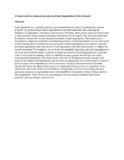/ library resources
Showing items 1 through 9 of 36.Land-use history, not readily available
for most places, remains the weakest link in nearly all
studies of historic vegetation change, in Africa as well
as other places in the world. Notwithstanding,
communities hold a great wealth of knowledge on the
Land is very central for human survival and development. In fact, it is so elemental to human
survival that it can be said that it is where life begins and it is where life ends. Land is the source
The abundance and diversity of soil mites was monitored along a gradient of land use types (LUTs) during the wet seasons in soils of Taita Taveta, Kenya.
Land degradation is a gradual, negative environmental process that is accelerated by human activities. Its gradual nature allows degradation to
proceed unnoticed, thus reducing the likelihood of appropriate and timely control action. Presently, there are few practical frameworks to help
In the semi-desert zone of North Horr, northern Kenya, soil salinity reaches toxic levels, with extensive salt crusts at the surface. Environmental groups are involved in tree and shrub planting trials with the objective of stabilizing sand dunes and rehabilitating land.
Climate change impacts livelihoods adversely in dry-lands of Northern Kenya in terms of longer and harsher droughts, shorter and intense precipitation and floods. Climate change interlocks with peoples life-worlds differently for different reasons.
Kenya’s land surface is primarily arid and semi-arid lands (ASALs) which account for 84% of the total land area.
Paginação
Land Library Search
Through our robust search engine, you can search for any item of the over 73,000 highly curated resources in the Land Library.
If you would like to find an overview of what is possible, feel free to peruse the Search Guide.





